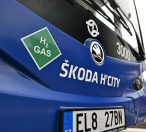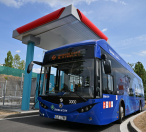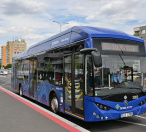Škoda H’CITY hydrogen bus in the streets of Prague
14. 07. 2023
The DPP, in cooperation with the Capital City of Prague and with companies Škoda Group and ORLEN Unipetrol, started the pilot operation of the first hydrogen bus with passengers in Prague on Friday, 14 July 2023. The Škoda H'CITY vehicle will travel on route no. 170 (Jižní Město – Pražská čtvrť). Based on the signed memorandum, the pilot operation will take place for two years, with the possibility of an extension for another two years.
Line no. 170 was selected by the DPP for the test operation of the first hydrogen bus based on basic criteria, such as the length and profile of the route or the type of vehicle deployed. Bus line no. 170 ensures a tangential connection between the Barrandov housing estate and the area of Jižní Město. It is one of the longest urban lines with 40 kilometres per circuit, it also has a hilly profile and is served by 12-metre Standard type buses. In addition, the route of the line runs near the Prague's first hydrogen filling station.
The pilot operation of the hydrogen bus in Prague public transport was approved by the Council of the Capital City of Prague in February of the last year. Based on this decision, in spring of the last year, the Capital City of Prague, the DPP, Škoda Group and ORLEN Unipetrol concluded a memorandum of cooperation in the implementation of this project.
The home garage of the bus will be Kačerov.
Basic technical parameters of the Škoda H'CITY hydrogen bus
The Škoda H'CITY hydrogen bus is a low-floor vehicle with full-body air conditioning equipped with Ballard FC Move 70 PEM fuel cells with a maximum output of 72 kW and a minimum output of 8 kW, in which electrical energy for traction drive is produced by the mutual reaction of hydrogen with oxygen from the air.
Water vapor is released into the air as a by-product of the chemical reaction. At the same time, the vehicle is equipped with a Nano Power LTO traction battery, 36 Ah, 22.9 kWh, which is used to balance output requirements (starting off, recuperation during braking), but also enables an emergency range of approximately two kilometres (e.g., for driving in the background of the Prague Public Transit Company).
A standardised CCS2 charging socket is available for potential separate charging and balancing of this battery. Waste heat from the fuel cell is used to heat the interior of the vehicle in winter, and additional electric heating is also available for very low temperatures.
- Length: 12.02 metre
- Width: 2.55 metre
- Height: 3.43 metre
- Number of seats: maximum 30 persons
- Total number of passengers: up to 85
- Space for wheelchairs or prams: 2
- Maximum speed: 80 km/h
- Range: up to 350 kilometres
- Maximum engine output: 160 kW
- Weight: 11,500 kilograms without passengers
- Capacity of hydrogen tanks: 39 kilograms
- Filling pressure: 35 megapascals (350 bars)
- Average declared consumption: approximately 10 kilograms of hydrogen per 100 kilometres in city traffic

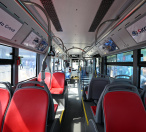
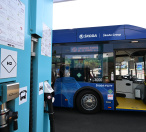
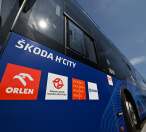
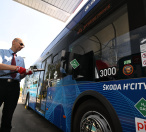
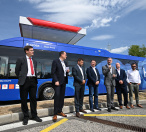 Show photo gallery (8)
Show photo gallery (8)